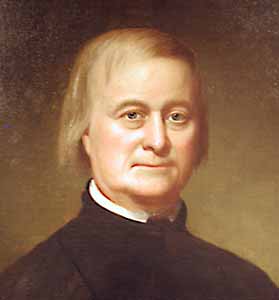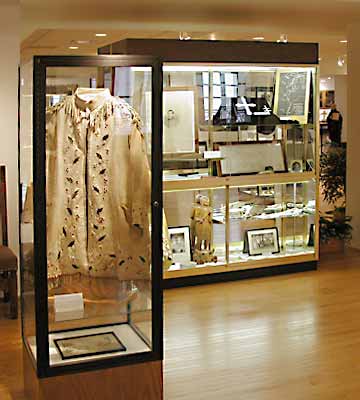
 |
home Jesuits prayer apostolates Rome locator |

The paintings of St. Ignatius and St. Francis Xavier originally stood at the entrance to the chapel at St. Stanislaus Seminary in Florissant, Missouri.
Saint Louis University opened the doors of its new Museum of Art on May 2 with a reception for the new Collection of the Western Jesuit Missions. The objects are tastefully spread out over the entire third floor of the new museum, housed in a mansion that originally belonged to the Woolworth stores corporation. For the opening, the university offered an exhibit of contemporary American Jesuit artists and another on Doctors of the Church along with Western Jesuit Missions which contains art and artifacts originally from St. Stanislaus Seminary in Florissant, Missouri on loan from the Missouri Province Jesuits.
The Collection of the Western Jesuit Missions is indicative of the spirit of the times surrounding the Jesuit seminary just north of St. Louis between 1823-1971. Priceless liturgical items include pre-French Revolution era silver and Baroque-era devotional art brought to the United States by famous missionary Father Pierre-Jean DeSmet SJ. Rooms illustrating Jesuit daily life at the seminary are complemented by exhibits reflective of Catholic life in St. Louis. Highlights of the exhibit include the original altar built for the novitiate by Jesuit craftsmen, rare terrestial and cellestial globes by Willem Blaeu and artifacts from the missionary experience of DeSmet and his fellow Jesuits of the Great Plains and the rocky Mountain West.

Father Pierre-Jean DeSmet led the first group of missionaries from St. Louis to Montana in 1841.

Among the many gifts DeSmet received from people he met in the Rocky Mountains was this deerskin jacket with cloth cut-outs.
Father David Suwalsky SJ interrupted work on his doctoral dissertation on the history of the 19th century frontier to spend four months serving as curator of this collection. The young historian had never before been a curator, and he welcomed the opportunity to put his theoretical knowledge of history to practical use. Suwalsky says he chose pieces that "illustrate what the Jesuits were about in the era of the seminary." He is content with the idea that the exhibit will communicate that story to many more people than would normally read an article in a historical journal.
"Our mission is to educate," he said; "if we don't use these objects for that mission, we should not keep them."

Dallas Woodson was a preparator of the collection, involved in the careful installation of artifacts in the new museum space.
The pieces began the move to the new Saint Louis University Museum of Art in January. According to Suwalsky, the university has been very generous in handling all the arrangements for installing the collection and providing insurance, security and environmental control.
The two large globes, one of the earth and the other of the heavens, were created around 1696 by famed Dutch cartographer Willem Blaeu. They reflect the state of geographical knowledge among European cartographers after more than a century of exploration and discovery. They also present the conceptual division in western European thought between heaven and earth, the natural and the supernatural. This is the only known pair of Blaeu globes in the Western hemisphere.

A major surprise was the altar from the old infirmary chapel as restorers removed heavy coats of white paint to reveal delicate wood carving underneath and gold-leaf embossed sun rays emanating from the HIS on the tabernacle doors. The collection of rare books also yielded several important documents left hidden in their pages. For example, inside one book Suwalsky found the deed for 70 acres which the province bought from a Pawnee woman at St. Mary's, Kansas in 1870; the site housed a school for Native Americans, then a boarding school and finally the school of theology for the province.
He also found a collection of 500 glass slides that portray scenes from around the world at the turn of the century. They appear to have been collected as a teaching aide, or could have been used in lectures. Another box contained 150 to 250 pages of German military documents from the period 1760 to 1830, from Prussia, Bavaria and Austria. The documents have signatures from noblemen and senior military officers and might have been saved for their signatures. The collection needs the attention of a military historian to decypher the story hidden in the elaborate handwriting of a bygone era.
The major discovery for Suwalsky is the large body of Christ crucified that now graces the foyer outside the collection. Initially the historian regarded the cross as a low point of artistry at the seminary because it was ineptly covered with latex paint; his plan was to remove the corpus in hope that the cross itself might be useable without the garish corpus. When curators removed the corpus, they discovered that it was walnut and had been carved in 1852. That picqued Suwalsky's interest so he asked the preparators to see whether paint could be removed. A small test section revealed the well-made craftsmanship obscured by the crude paint job. They decided to restore the whole cross and ended up creating the strong piece that introduces the whole collection.
Father Suwalsky says his favorite piece is an alabaster medallion with an image of the Immaculate Conception on one side and a delicate portrait of St. Ignatius on the other.